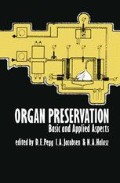Abstract
Ischaemic tissue rapidly becomes acidotic and it has been shown that a fall in pH has a deleterious effect on a number of tissues, including decreased oxygen consumption in diaphragm1 and loss of contractility2 in association with the depression of several metabolic processes3 in myocardium. A number of studies have sought to correlate tissue pH during ischaemia with renal viability. Surface pH is easily measured but has not been found to be consistently helpful4,5. The pH on the surface may not be an accurate reflection of changes within tissue or cells. Other workers have approached the problem by attempting to modify renal viability by using buffered flush solutions, but in the absence of measurements of pH a cause-and-effect relationship cannot be substantiated6,7. A major obstacle in this field is the difficulty in measuring intracellular pH, particularly under conditions of ischaemia8,9. Nuclear magnetic resonance (NMR) spectroscopy using the 31P nucleus has been shown to be a reliable means of measuring pH even during ischaemia10–13 since it is able to determine the degree of protonation of inorganic phosphate14. We have measured pH by 31P NMR in three series of experiments.
Access this chapter
Tax calculation will be finalised at checkout
Purchases are for personal use only
Preview
Unable to display preview. Download preview PDF.
References
Enerson, D. M. and Berman, H. M. (1966). Effects of hypotonicity, low molecular weight dextran addition and pH changes on oxygen consumption of isolated tissues. Ann. Surg., 163, 537
Poole-Wilson, P.A. and Langer, G.A. (1975). Effect of pH on ionic exchange and function in the rat and rabbit myocardium. Am. J. Physiol., 229, 570
Williamson, J. R., Schaffer, S. W., Ford, C. and Safer, B. (1976). Contribution of tissue acidosis to ischaemic injury in the perfused heart. Circulation, 53 (suppl. 1), 1
Couch, N. P., Maginn, R. R., Middleton, M. K., Appleton, D. R. and Dmochowski, J. R. (1967). Effects of ischaemic interval and temperature on renal surface hydrogen ion concentration. Surg. Gynaecol. Obstet., 125, 521
Hardie, I. R., Clunie, G. J. A. and Collins, G. M. (1973). Evaluation of a simple means of assessing renal ischaemic injury. Surg. Gynaecol. Obstet., 136, 43
Collins, G.M., Hartley, L.C.J, and Clunie, G.J.A. (1971). Kidney preservation for transportation. 5. Comparison of perfusates for hypothermic storage. Med. J. Aust., 1, 1171
Lannon, S.G., Bickis, I. and Dossetor, J.B. (1971). Viability testing of kidneys for transplantation. Invest. Urol., 9, 180
Cohen, R.D. and Lies, R.A. (1975). Intracellular pH: measurement, control and metabolic interrelationships. Crit. Rev. Clin. Lab. Sci., 6, 101
Poole-Wilson, P.A. (1978). Measurement of myocardial intracellular pH in pathological states. J. Molec. Cell. Cardiol., 10, 511
Radda, G.K. and Seeley, P.J. (1979). Recent studies on cellular metabolism by nuclear magnetic resonance. Ann. Rev. Physiol., 41, 749
Gadian, G. D., Radda, G. K., Richards, R. E. and Seeley, P. J. (1979). 3ip NMR in living tissue. In Shulman, R. G. (ed.), Biological Applications of Magnetic Resonance, pp. 463–535. ( New York: Academic Press )
Garlick, P. B., Radda, G. K. and Seeley, P. J. (1979). Studies of acidosis in the ischaemic heart by phosphorus nuclear magnetic resonance. Biochem. J., 184, 547
Bailey, I.A., Williams, S.R., Radda, G.K. and Gadian, D.G. (1981). The activity of Phosphorylase in total global ischaemia in the rat heart; a 31P NMR study. Biochem. J., 196, 171
Garlick, P. B., Radda, G. K. and Seeley, P. J. (1979). Studies of acidosis in the ischaemic heart by phosphorus nuclear magnetic resonance. Biochem. J., 184, 547
Bore, P.J., Sehr, P.A., Chan, L., Thulborn, K.R. and Radda, G.K. (1981). The importance of pH in renal preservation. Transplant. Proc., 13, 707
Thulborn, K.R., Chan, L., Radda, G.K., Bore, P.J. and Ross, B.D. (1982). Maintenance of physiological pH during hypothermic storage of ischaemic rat kidney. (In preparation)
Editor information
Editors and Affiliations
Rights and permissions
Copyright information
© 1982 MTP Press Limited
About this chapter
Cite this chapter
Sehr, P., Bore, P., Thulborn, K., Papatheofanis, I., Chan, L., Radda, G.K. (1982). Tissue pH changes in renal preservation. In: Pegg, D.E., Jacobsen, I.A., Halasz, N.A. (eds) Organ Preservation. Springer, Dordrecht. https://doi.org/10.1007/978-94-011-6267-8_13
Download citation
DOI: https://doi.org/10.1007/978-94-011-6267-8_13
Publisher Name: Springer, Dordrecht
Print ISBN: 978-94-011-6269-2
Online ISBN: 978-94-011-6267-8
eBook Packages: Springer Book Archive

